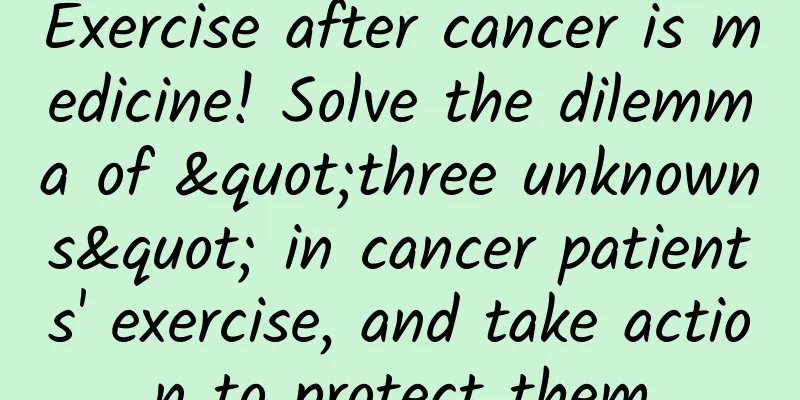Exercise after cancer is medicine! Solve the dilemma of "three unknowns" in cancer patients' exercise, and take action to protect them

|
Exercise after cancer is medicine! However, cancer patients often face the situation of "not knowing three things" when exercising after treatment. The Cancer Hope Foundation has taken the lead in promoting the "Post-cancer Exercise Prescription, "5" Protections with Movement" proposition, which aims to strengthen the five core abilities of cancer patients, namely "muscle strength, muscle endurance, agility, balance, and cardiopulmonary function", in order to enhance the physical activity of patients and improve the overall recovery effect. The latest cancer registration data shows that the number of newly diagnosed cancer patients in Taiwan is as high as 121,762 each year. Fortunately, due to the rapid development of cancer treatment technology, the five-year relative survival rate of all cancers has improved from 40.7% in 1992-1995 to 62.1% in 2017-2011. Such changes have extended the focus of cancer treatment from eliminating life-threatening cancer cells to post-cancer recovery. Internationally, the American Cancer Society, the Clinical Oncology Society of Australia (COSA) and other international societies have jointly launched the "Exercise is Medicine" campaign, pointing out that post-cancer exercise should be included as one of the "prescriptions" in the post-cancer follow-up stage. In response to this demand, the Cancer Hope Foundation proposed the "Post-cancer Exercise Prescription, "5" Protections with Movement" proposition, which aims to strengthen the five core abilities of cancer patients, namely "muscle strength, muscle endurance, agility, balance, and cardiopulmonary function", rebuild their body functions, effectively enhance their ability to carry out daily activities, and improve the overall recovery effect. Only in this way can we truly "have" protection by moving. Post-cancer exercise prescription, "5" of movement for protection (Photo courtesy of Cancer Hope Foundation) Dr. Cheng-yi Hsieh, honorary director of the Cancer Hope Foundation and director of the Department of Hematology and Oncology at Taipei Medical University Hospital, said that HOPE spent two years understanding international trends and investigating the current situation of patients in Taiwan. Through adjustments and revisions based on practical experience, it launched the "Post-Cancer Exercise Prescription" in the hope of integrating exercise training into cancer care to enhance patients' physical activity and break away from a sedentary lifestyle. Through physical assessment by a physical therapist and collaboration with a certified coach, the key is the active participation of the patient, taking responsibility for their own health and maintaining a healthy life. "Post-cancer exercise prescription" correctly and effectively enhances the physical fitness of cancer patientsLegislator Wang Zhengxu also pointed out that in response to President Lai Ching-te’s 2030 “Healthy Taiwan” three-arrow policy goal of “reducing cancer mortality by one third,” in addition to good cancer screening and cancer treatment, the post-cancer recovery stage is also very critical. He echoed the idea of "Exercise is Medicine" and stressed that both "post-cancer exercise" and "post-cancer follow-up" should be given equal attention in the post-cancer recovery stage. The fifth phase of our country's National Cancer Prevention and Control Plan proposes that "exercise is one of the strategies to prevent cancer." Regular exercise can effectively reduce the incidence of certain cancers, such as breast cancer, colorectal cancer, and endometrial cancer. Currently, the Cancer Hope Foundation has taken the lead in implementing the "Post-Cancer Exercise Prescription". He hopes that the government can also "pre-deploy" in terms of exercise policies for cancer patients, integrate the resources of hospitals and communities, take stock of relevant resources from the central government and counties and cities, strengthen cross-departmental cooperation, and ensure that cancer patients receive all-round support during the recovery process. Furthermore, he also called on cancer patients to actively participate in protecting their own health. The "Post-Cancer Exercise Prescription" can correctly and effectively enhance the physical fitness of cancer patients, so that they can live longer and live better, which is also the important significance of promoting "Healthy Taiwan". Taiwanese cancer patients' "exercise barriers" include adverse physical reactions and limited adviceExercise can reduce the risk of recurrence and improve anxiety and depression. The American Cancer Society (ACS) also recommends that "exercise prescription" be included as an important part of post-cancer treatment. In Taiwan, most cancer patients know that they need to exercise, but are they doing it "right"? Xie Zhengyi pointed out that according to a research survey conducted by the Cancer Hope Foundation and the Department of Sports Medicine of Kaohsiung Medical University, although post-cancer patients "get moving", nearly 80% prefer walking, indicating that although they move, they do not move "effectively"; and nearly 60% of patients did not receive reminders from medical staff to exercise, and although the remaining 40% of patients accepted the advice of medical staff, the recommended method was mostly "walking", indicating that medical staff still have limitations in their understanding of exercise for cancer patients, and do not realize that there should be cross-professional integration of rehabilitation and coaching. On the other hand, more than 40% of patients’ movement disorders are caused by adverse reactions after treatment. In fact, international literature shows that exercise can reduce the medium- and long-term side effects after cancer treatment, such as fatigue, lymphedema, improve sleep, and reduce anxiety and depression. Solve the dilemma of "three unknowns" for cancer patients, and provide comprehensive assistance with "5" protectionPhysiotherapist Lin Zhaoyin pointed out that cancer patients often face "three unknowns" when exercising after treatment: 1. I don’t know when to move? 】: Many cancer patients are unsure about when to start exercising after treatment. 2. I don’t know how to move? 】: Even if they want to exercise, cancer patients often lack the correct knowledge of exercise and worry that improper movements during exercise will cause physical harm. For example, patients who have had 1/3 of their stomach removed due to gastric cancer are not suitable for training to increase abdominal pressure. 3. I don’t know who to look for? 】: During the recovery process of cancer patients, I don’t know where to find professional coaches who understand the limitations or risks related to cancer to provide guidance. The Cancer Hope Foundation has taken the lead in promoting the "Post-cancer Exercise Prescription, 5" Protection with Movement" initiative, which aims to strengthen the five core abilities of cancer patients, namely "muscle strength, muscle endurance, agility, balance, and cardiopulmonary function", in order to enhance the physical activity of patients and improve the overall recovery effect. (Photo courtesy of Cancer Hope Foundation) Lin Guanting, the official instructor of the National Strength and Conditioning Association (NSCA), emphasized that exercise for cancer patients is not as simple as just moving. It requires "proper movement" and training of the five core abilities of muscle strength, muscle endurance, agility, balance, and cardiopulmonary function in order to achieve effective exercise. Gao, a fitness coach who had undergone laparotomy and multiple chemotherapy sessions for ovarian cancer, said that even though she was a fitness coach, after being diagnosed with cancer, she also faced movement disorders, not knowing when, how, and who to move with. Therefore, when I learned that the Foundation launched the "Post-Cancer Exercise Prescription", I joined as a volunteer to accompany patients in training. I am currently a certified coach, hoping to help more cancer patients recover better and longer. Cancer Hope Foundation launches "Post-cancer Exercise Prescription" and trains coachesThe Cancer Hope Foundation deeply understands the importance of post-cancer exercise. Since 2022, it has cooperated with lecturer Lin Guanting to plan a three-month 12-class "Post-Cancer Exercise Prescription" course. So far, a total of 20 groups of cancer patients have participated in the "Post-Cancer Exercise Prescription". The course content includes training of different muscle groups and reaction forces, so that cancer patients can gradually strengthen their physical strength. The results of the post-class questionnaire survey showed that through the post-cancer exercise prescription, the proportion of people who maintained the exercise habit after class was as high as 85%, and the fatigue level and overall quality of life were improved as shown by relevant scales. In the future, the Foundation will continue to run special classes on "Post-Cancer Exercise Prescriptions" to allow cancer patients in all counties and cities across Taiwan to have the opportunity to receive guidance from professional coaches and replace long-term care with regular training, thereby improving their physical abilities. In addition, the road to post-cancer recovery requires the assistance of a professional team. Therefore, the Cancer Hope Foundation has specially launched the "Post-Cancer Exercise Prescription" training coach certification course, integrating a professional team with more than 20 years of medical and sports clinical experience to cultivate the first batch of 18 professional sports coaches. The list of coaches is placed on the [Taiwan Cancer Resource Network], so that cancer patients who want to exercise effectively can find and train with peace of mind. At the same time, we launched the online [Hope Gym] so that cancer patients can maintain good exercise habits through this channel after the course and continue to do rehabilitation exercises with the professional training team. |
Recommend
30% of herbal tea samples tested in Nantou found excessive pesticide residues
Modern people lead a fast-paced and stressful lif...
There is a reason for gaining weight! 6 bad habits make you gain 1 kg without realizing it
Are you very upset? Why do you gain weight unknow...
What are the main risks of irregular menstruation?
There are many women who suffer from irregular me...
Causes of pelvic inflammatory disease that require special attention in daily life
The cause of pelvic inflammatory disease is close...
What are the symptoms of irregular menstruation
What are the symptoms of irregular menstruation? ...
How to treat intramural uterine fibroids? Common treatment methods for intramural uterine fibroids
How to treat intramural uterine fibroids? Can con...
How harmful is ectopic pregnancy to women?
How harmful is ectopic pregnancy to women? Whethe...
Can congenital absence of vagina be prevented?
Congenital absence of vagina is a common malforma...
The cause of bilateral obstruction of fallopian tubes
The fallopian tube is not smooth. The fallopian t...
Can drinking fruit water help detoxify and lose weight? Nutritionist: Lemon, mint and cucumber are three powerful characters
It is popular abroad to make your own fruit water...
Symptoms of dysmenorrhea that women should pay attention to
In real life, dysmenorrhea is a very common gynec...
What are the more effective preventive measures for vaginitis?
Vaginitis is very harmful to women. Many people i...
Three quick steps to slim your face: puff up your lips and do exercises
[Core Tip]: Do you know the fastest way to slim y...
What are the specific causes of pelvic inflammatory disease?
Pelvic inflammatory disease has always affected t...
Treatment of menopausal dysfunctional uterine bleeding
Aunt Zhao, 46, came to Beijing to settle down wit...









